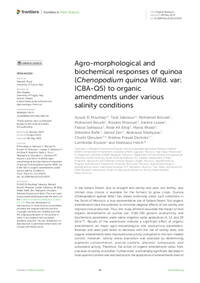Agro-morphological and biochemical responses of quinoa (Chenopodium quinoa Willd. var: ICBA-Q5) to organic amendments under various salinity conditions

Authors:
n the Sahara Desert, due to drought and salinity and poor soil fertility, very
limited crop choice is available for the farmers to grow crops. Quinoa
(Chenopodium quinoa Willd.) has shown promising under such conditions in
the South of Morocco, a true representative site of Sahara Desert. Soil organic
amendments have the potential to minimize negative effects of soil salinity and
improve crop production. Thus, this study aimed to elucidate the impact of nine
organic amendments on quinoa (var. ICBA-Q5) growth, productivity, and
biochemical parameters under saline irrigation water application (4, 12, and 20
dS·m-1). Results of the experiment indicate a significant effect of organic
amendments on major agro-morphological and productivity parameters.
Biomass and seed yield tends to decrease with the rise of salinity level, and
organic amendments have improved productivity compared to the non-treated
control. However, salinity stress alleviation was assessed by determining
pigments concentration, proline content, phenolic compounds, and
antioxidant activity. Therefore, the action of organic amendments varies from one level of salinity to another. Furthermore, a remarkably significant decrease in
saponin content was reached due to the application of amendments even at high saline conditions (20 dS·m-1). The results demonstrate the possibility of enhancing the productivity of quinoa as an alternative food crop under salinity conditions by using organic amendments and improving the quality of grains (saponin reduction) during the pre-industrialization process.
